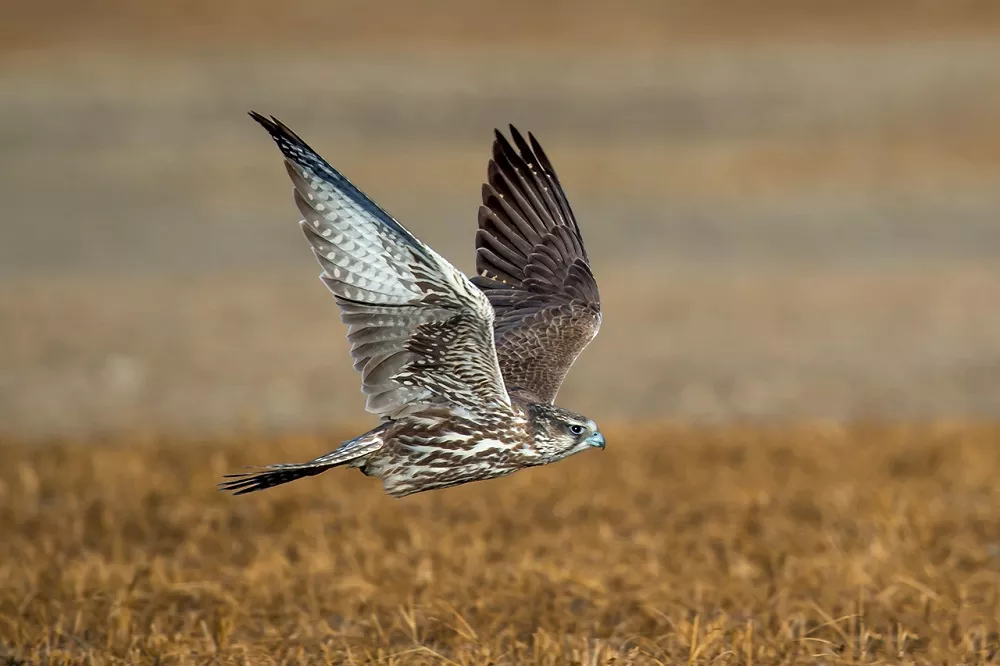The saker falcon (Falco cherrug) is a large species of falcon. This species breeds from central Europe eastwards across the Palearctic to Manchuria. It is mainly migratory except in the southernmost parts of its range, wintering in Ethiopia, the Arabian peninsula, northern Pakistan and western China. The saker falcon is the second fastest bird in level flight after the white-throated needletail swift, capable of reaching 150 km/h (93 mph). It is also the 3rd fastest animal in the world overall after the peregrine falcon and the golden eagle, with all three species capable of executing high speed dives known as “swooping”, in excess of 320 km/h (200 mph). The saker falcon is the national bird of Hungary, the United Arab Emirates, and Mongolia .
What does a saker falcon look like
Saker falcon has white forehead and brow lines, creamy white on top of head, side of neck and back of neck, slightly stained with light brown, with dark brown markings. The rest of the upper body is dark brown, with dark brown longitudinal stripes and regular cinnamon yellow or brown yellow horizontal spots and feather tips, the overlying feathers on the waist and tail are slightly lighter; the tail feathers are dark brown with brown yellow horizontal spots, the tip of the outer tail feathers and the base of the inner valve Feather margins are milky white; wing primary feathers are dark brown with dark brown feather tips; flight feathers have a little brownish-yellow spots or milky-white tooth-like markings, and base feathers are milky-white; secondary flight feathers are dark brown with brownish-yellow spots or horizontal Spots; wing coverts are dark brown, feather margins are light brownish yellow, large coverts and inner middle coverts have brownish yellow horizontal spots.
The underparts are white with yellow skin, the chest and abdomen have dark brown feather stem lines, and the feather tips are decorated with dark brown drop-shaped and sagittal spots; the two sides and the outer upper half of the covert feathers have broad dark brown horizontal spots, and the covert feathers The inner and outer lower half are creamy white with sparse dark brown longitudinal stripes; the undertail coverts are also creamy white with dark brown longitudinal stripes; the underwing coverts and axillary feathers are yellow with dark brown markings.
Juveniles are similar to adults, but with thicker vertical stripes on the top of the head and narrow milky white feather margins. The upper body is also darker, with only light feather margins and no horizontal spots. The lower body is also slightly darker, and the throat has slender dark brown longitudinal stripes. Wing coverts and axillary feathers creamy white with broad dark brown longitudinal stripes.
The iris is dark brown, the bill is lead blue-gray, the tip is black, the base is yellow-green, the wax film is dark yellow, the feet and toes are yellow-green, the claws are black, and the iris, feet and toes of young birds are blue-gray.
Saker Falcon habitat
It mainly lives in inland grasslands and hilly areas, and inhabits open areas in mountains, river valleys, deserts and grasslands. Often found in moist forests, forests and semi-desert steppes as well as open plains, which favors their predation patterns. Saker falcons can occupy mountain slopes up to 4,700 meters above sea level. It is active in wilderness and rocky hills with no forest or only a few trees.
Saker Falcon behavior
- Migration
Saker falcons living in Russia migrate, avoiding the harshness of the continental climate, to the Middle East and Northeast Africa. Saker falcons in other areas are resident birds or occasional wanderers.
- Hunting
Saker falcons hunt in flight, always using surprise to hunt in flight. However, they also occasionally catch beetles on the ground while walking. Whenever it finds prey on the ground, this species always uses its narrow wings that can reduce drag like a high-speed aircraft to fly above the prey, occupy the commanding heights, and then fold its wings so that the flight feathers on the wings and the body The longitudinal axis is parallel, and the head is retracted to the shoulders. At a speed of 75-100 meters per second, it rushes towards the prey at an angle of 25 degrees. When it is close to the prey, it slightly spreads its wings and strikes or grabs with its hind toes and claws. prey.
- Food
Saker falcons can attack flying chickadees, larks and other small birds in the air like fighter jets. After catching up with the prey, they use their wings to strike until the prey loses the ability to fly, falls from the air, and then swoops down to capture it.
The two main food sources are rodents, which include chipmunks, voles, lemmings and moles, and birds, which include pigeons and partridges, ranging in size from larks to herons.
Distribution area of Saker falcon
Distributed in Central Europe, North Africa, northern India, Central Asia to Mongolia and northern China.


 Facebook
Facebook  Instagram
Instagram  Youtube
Youtube 